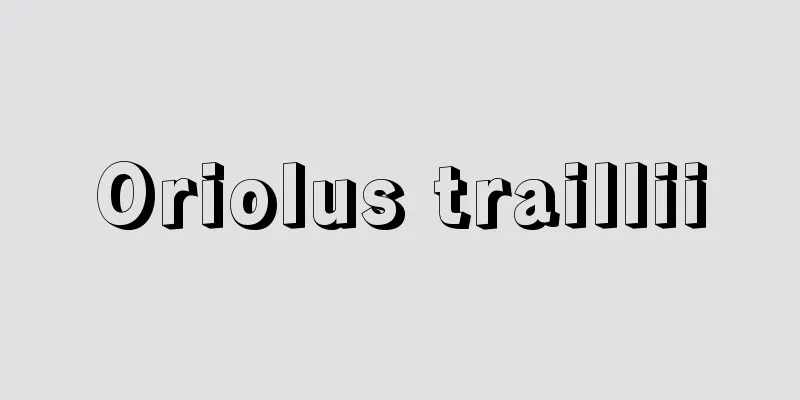Waka - Waka

|
Yamauta means songs unique to Japan, but the concept was established with the creation of the Kokin Wakashu in the Heian period, and so the specific waka styles that were recognized as unique at the time were tanka, choka, sentouka, and bussokusekika, and these have remained within the narrow definition of waka up to the present day. Based on a syllable count rule of repeating five-syllable phrases and seven-syllable phrases, there are tanka of 5-7-5-7-7, choka with the basic form of repeating 5-7 three or more times and concluding with a seven, sentouka with two repetitions of 5-7-7 (called katauta on its own), and the bussokusekika style, which adds a seven to the tanka form and is inscribed on the Buddha's Foot Stone Monument at Yakushiji Temple in Nara, and all of these can be found in the Manyoshu. The majority of the poems in the Manyoshu are tanka, followed by choka, and while choka have been produced intermittently up to the present day in specific cases or in connection with respect for the Manyoshu, it is tanka that have been produced without interruption, so much so that the history of waka can be called the history of tanka. The first surviving collection of poems is the Manyoshu, and from the Heian to Muromachi periods, 21 imperially commissioned anthologies of waka were compiled, but there are also many privately commissioned and privately owned anthologies. In modern times, most collections of poems are personal anthologies. Renga (linked verse) evolved from tanka, which gave rise to haikai (linked verse), and among the tanka forms are kyoka (curious poems) that are not elegant, rakushu (satirical poems), doka (moral poems) that teach moral lessons, and even uta (divination) and incantation songs. Many of Japan's traditional poems are rooted in tanka, and have had a major influence on popular song forms. It should also be noted that waka studies, which are used to study waka, were already systematized at the end of the Heian period, and have continued to be the core of Japanese classical (cultural) studies ever since. [Haruo Fujihira] "New Edition of the National Poetry Compilation Committee, 'New Edition of the National Poetry Compilation,' 10 volumes, 20 books (1983-87, Kadokawa Shoten)" ▽ "Waka Literature Society, 'Waka Literature Lectures,' 12 volumes (1969-70 / reprint, 1984, Ohfusha)" [Reference] |Source: Shogakukan Encyclopedia Nipponica About Encyclopedia Nipponica Information | Legend |
|
「やまとうた」すなわち日本の国の固有の歌を意味するが、その概念は平安時代の『古今和歌集』の成立によって確立したので、具体的な和歌の歌体としては、その当時固有の歌体として認められていた短歌・長歌および旋頭歌(せどうか)・仏足石歌(ぶっそくせきか)体をさすことになり、それが現代に至るまで狭義の和歌の範囲となってきている。五音節句と七音節句との繰り返しによる音数律が基本となって、五七五七七の短歌、五七を三回以上繰り返して七で結ぶのが基本形式の長歌、五七七(それだけを片歌(かたうた)とよぶ)を二度繰り返す旋頭歌、それと奈良の薬師寺の仏足石碑に刻まれた、短歌形式にさらに七の加わった歌体の仏足石歌体があり、それぞれ『万葉集』にもみいだせる。『万葉集』所収歌の大部分は短歌、ついで長歌であり、長歌は、特定の場合や『万葉集』尊重と結び付いて間欠的につくられつつ現代に至るが、絶えることなくつくられ続けたのは短歌で、和歌史は短歌史といいかえていいほどである。現存する歌集の最初は『万葉集』であり、平安時代から室町時代にかけて勅撰(ちょくせん)和歌集21集が成立しているが、そのほか私撰集・私家(しか)集も多い。近代になるとほとんど個人歌集である。短歌から連歌(れんが)が分化し、それが俳諧(はいかい)(連句(れんく))を生じたし、短歌形式のものでは優美さから外れた狂歌(きょうか)や、風刺性をもつ落首(らくしゅ)、教訓のための道歌(どうか)、さらには歌(うた)占いやまじない歌まで、日本の伝統詩歌には短歌に根ざすものが多く、歌謡形式にも大きな影響を与えている。和歌研究のための歌学は平安時代末期にすでに体系化され、以後日本の古典(文化)学の中軸となり続けてきたことにも注意しなければならない。 [藤平春男] 『新編国歌大観編集委員会編『新編国歌大観』全10巻20冊(1983~87・角川書店)』▽『和歌文学会編『和歌文学講座』全12巻(1969~70/再版・1984・桜楓社)』 [参照項目] |出典 小学館 日本大百科全書(ニッポニカ)日本大百科全書(ニッポニカ)について 情報 | 凡例 |
>>: Chord - waon (English spelling)
Recommend
attribution
...Authentication naturally involves the question...
Silver scriptures - Ginjikyo
...Its origins can probably be traced back to the...
quantitative analysis
…Chemical analysis is the process of clarifying w...
Dolmabahçe Sarayı (English spelling)
… [Westernization and urban transformation] After...
Amida-ga-mine
It is one of the 36 peaks of Higashiyama in the ea...
Reciprocating Pump - Oufuku Pump
A type of positive displacement pump that pumps l...
Echeverria, L. - Echeverria
...However, problems lurked behind this miracle, ...
Mount Udo
A hilly mountain in Shizuoka City. It is 307 mete...
S (chord) - S
...Today, when people generally talk about tonali...
Kai Fukuda - Fukudenkai
A religion founded in 1908 by Nakayama Tsuyu (1862...
Gatterer, JC (English spelling) GattererJC
...In the 18th century (link), geography was defi...
Odon - Odon
…It is valuable as the most reliable and rare sou...
Ibukikogomegusa - Ibukikogomegusa
→ Eyelashes Source : Heibonsha Encyclopedia About ...
fifo
《 first-in, first-out 》⇒First-in, first-out FIFO [...
Wife - Okugata
[1] 〘 noun 〙① A secluded area in a samurai's r...






![Sutlej [River] - Sutlej](/upload/images/67cbad2778576.webp)


